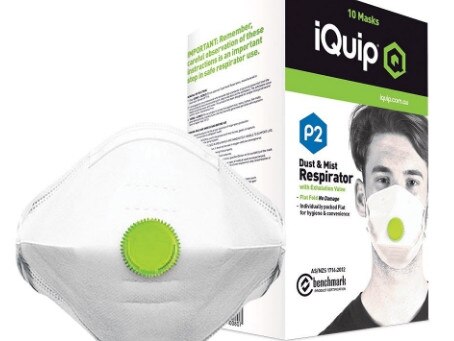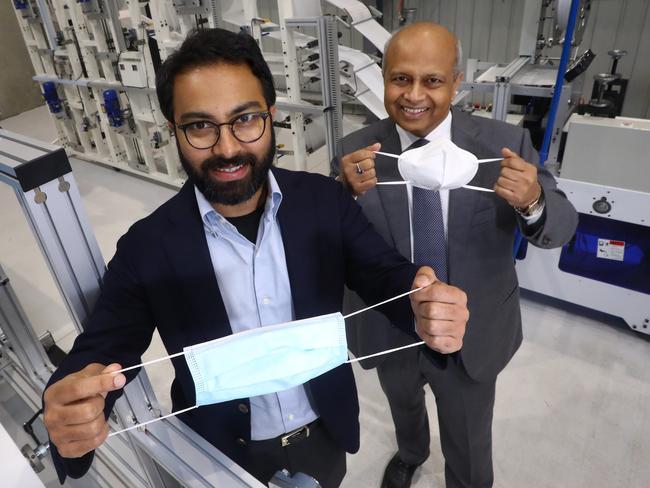How you could get COVID-19 if you don’t wear a face mask correctly
A leading infectious disease expert answers the top 10 questions about how to use a face mask and reveals you are at risk of getting COVID-19 if you don’t do it the right way.
You could be at risk of becoming infected with coronavirus if you don’t remove your face mask correctly, infectious diseases experts have warned.
The NSW and Victorian governments are urging people to wear face masks in public as coronavirus continues to spread and as new evidence emerges the virus could be airborne.
Mary-Louise McLaws, Professor Epidemiology of Hospital Infection and Infectious Diseases Control at the University of New South Wales, and a member of the World Health Organisation (WHO) Health Emergencies Program Experts Adviser answers the burning questions about how to use a face mask correctly.

When should you wear a mask?
A. When you can’t keep physical distance of at least 1.5 metres such as public transport, airports, planes, lifts, shopping malls, cinemas sporting venues.
What is the best type of mask to wear?
A. A medical grade mask provides the best protection. Protection is measured in terms of filtration of particles and a medical mask (or sometimes referred to as a surgical mask) provides 95 per cent to 98 per cent filtration protection. If a medical grade mask is unavailable then a cloth mask made from three layers of cloth can provide up to 60 per cent protection, and some up to 70 per cent, depending on the construction, choice of material and number of layers used. A mask must be breathable and comfortable. When two layered a fabric mask provides 2-5 times more filtration when the layers are increased The World Health Organisation has a website to explain the required material and shape.

What materials should a mask be made of?
A. In brief the materials should include an outer layer that is water repellent, an inner layer made from polyester or polypropylene and a layer closest to your face made of a soft cotton to absorb moisture. The mask must cover the bridge of your nose, come under your chin and cover the sides of your face coming around to the joint of your jaw bones.
How do you wear a mask?
A. To protect yourself and others the mask must be placed over both the mouth and nose at all times while you are in a publicly shared space where you cannot keep a physical distance from others of at least 1.5 metres. This is important as the mask material filters out viral particles from air breathed out of the mouth and nose from someone who may not realise that they are infectious and it protects others from breathing in COVID-19 particles through their nose or mouth. A mask will not work if the mask is placed under your chin exposing your nose and mouth or if you place the mask under your nose.

How often should you change a mask?
A. All masks, cloth or medical grade masks are not effective if they are damp or wet. In a hospital health workers change their medical mask often but for the public if you have plenty of medical masks you could change it daily or replace it when it becomes moist. If the mask looks dirty replace the medical mask or wash the fabric/cloth mask. It is very important to try to not touch your mask unless your hands are freshly cleansed. So keep a small bottle of alcohol based hand rub on you
Can you re-use a disposable mask?
A. There is little published science but the risk of contamination from reusing your medical mask is low when you use a mask in the community. But replacing the mask each day is preferable.

How do you remove a mask?
A. Clean your hands before you remove the mask and store it in a ziplocked (or paper) bag. If the style of mask allows it, remove the mask taking it away from your face by holding the ear loops or ties. Make sure you pull the mask out from your face not downwards or upwards as you do not want any risk of contact with the outside of the mask and your mouth or eyes. Bend the mask inwards so the outer side is facing inwards. Now wash hands with the alcohol based hand rub.
How do you store a used face mask?
A. Place it in a ziplocked (or paper) bag and afterwards wash your hands with alcohol based hand rub before touching your face.
How do you wash a re-usable mask?
A. There is little published science, but the risk of contamination from reusing your medical mask is low when you use a mask in the community. But replacing the mask each day is preferable.
If you use a fabric/cloth mask remove it use the same procedure as above — move it away from your face and place it into a ziplocked (or paper) bag. At the end of each day wash it delicately, in warm soapy or detergent and water. The water temperature is best at 60 detergent and if this temperature cannot be achieved give the mask a final rinse with boiled water or soak it in a weak bleach (0.1 per cent) for 1 minute. Then rinse the mask with room temperature water. Detergent is important as the virus can be inactivated by detergent or a weak bleach) rinse and dry for the next day. Store it in a clean bag. The World Health Organisation is working with researchers to establish the construction and composition for fabric masks that can provide the highest filtration.
If you can’t find a mask what alternatives work? Holding a sleeve over your mouth and nose? A handkerchief? A tea towel?
A. Any mask is better than a bare face in a crowded public place. Even tissue paper provide 20 per cent filtration, exercise pant material 23 per cent, sweater shirt up to over 40 per cent. But remember to try to keep your distance whenever possible even while wearing a mask.
Originally published as How you could get COVID-19 if you don’t wear a face mask correctly
